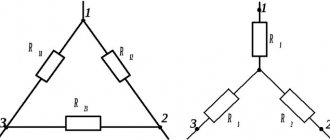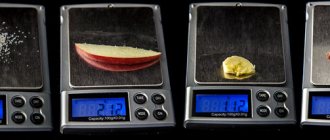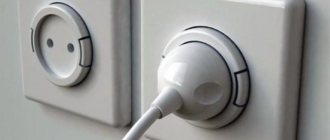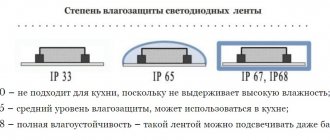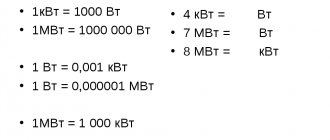Designation kW
Kilowatt is written as kW. It is a unit of power divided by the derived SI unit watt. Watt denotes the power at which 1 joule (J) of work is performed or energy is consumed in 1 second.
Power consumed by household appliances
Another watt is defined as the speed of work at which a constant motion of a body of 1 meter per second is ensured, if at this time a force equal to 1 newton is overcome, going in the direction opposite to the direction of movement of the object.
The power of household appliances is measured in kilowatts. The abbreviation kilowatt denotes work:
- lamp;
- TV;
- vacuum cleaner;
- microwave;
- refrigerator;
- combine;
- mixer.
The hair dryer has a power of 1.5 kW
Is it possible to connect a 3.5 kW instantaneous water heater to a regular outlet?
Is it possible to connect a 3.5 kW instantaneous water heater to a regular outlet?
First, you need to decide what load that “regular” outlet is designed for.
So, for example, a 16 Ampere outlet, but back to back, which is not desirable (the load can be short-term, can be long-term), will withstand a load of 3.5 kW.
Sockets for 10 or 6 Amps are definitely not suitable for these purposes.
If the outlet is 16 Amperes or more, then in principle you can connect it, but again, if nothing else is connected to this outlet.
That is, the total load must be taken into account.
Plus, the wiring also works in conjunction with the socket, that is, it is imperative to take into account the cross-section of the wire core and + what material those same wires are made of; copper can withstand a greater load, unlike aluminum.
With storage water heaters, everything is not much simpler, even if they have two heating elements, their total power is still less than the power of an instantaneous water heater.
I advise you not to experiment with ordinary sockets, but to “throw” a separate wiring from the panel under such a water heater and to the wiring there is its own separate socket.
For stable operation of an instantaneous water heater, I advise you not to connect it to a regular outlet and not to change the machine from 16 to 25, but to install a separate power line with a wire with a cross-section of 4 square millimeters, and install the machine at 25 Amps.
Source
Converting kW to W and vice versa
Similar to other units of measurement, the prefix “kilo” means 1000. To convert a watt to a kilowatt, you need to use the formula:
1 kW=1000 W.
If the mixer says 1.6 kW, this means that its power in watts will be 1600. If you convert it back, then the number of watts is divided by 1000. An incandescent lamp has a power of 100 W, which is the same as 0.1 kW.
Example of conversion of 2 kilowatts (2 kW): 2*1000=2000 W.
It is easy to find out the power of the device - you will need to study the technical documentation for the device or look at the markings located on the case.
On a Bosch iron, the indicator is marked on the side
Now you can easily calculate and convert units. There are various online calculators for this. They enter a query into the search bar and go to the site.
Example
To convert the specified parameters of an electrical device from kW to W, it is necessary to clarify the information from the markings on the product body, or obtain data from the equipment passport developed by the manufacturer and included in the product package.
If it is determined that the power rating of an electric kettle is 2.2 kW, this means that in watts this value will be 2.2 x 1000 = 2200 W.
In some situations, it is necessary to determine the value of the total power characteristics of household consuming devices. This need may arise in the following cases:
- to select a sufficient cable diameter when installing electrical wiring;
- when choosing safety devices that disconnect the network if the parameters exceed permissible values;
- to ensure the correct layout of household equipment in the house and proper wiring.
The calculation is performed by summing the above indicators for each of the devices. After this, the obtained value is compared with that indicated as a control value in the characteristics of the cable or safety devices, and is taken into account when locating the equipment.
For the calculation to be correct, all values must first be converted into common units of measurement from watts to kilowatts or vice versa, using the previously described method.
Power measurement in kW
The most well-known way to measure power in everyday life is to look at the meter. On it you can see not only electricity consumption.
A modern meter shows light consumption at night, during the day, on holidays, as well as power P
Not all meters show power, but all models measure:
- number of disk revolutions in one kW per hour;
- number of pulses, how many times the 1 kWh indicator lights up.
If the information is available, the user can easily determine the value.
Using a current clamp meter, you can compare the actual reading with what the meter shows
There is a special meter for the socket. Its other name is energy meter or wattmeter. The device is sold in electrical stores. The device will help measure the following indicators:
- currently consumed power;
- consumption over a certain period of time;
- current;
- voltage;
- costs at specific tariffs.
You might be interested in: Number and layout of sockets in the kitchen
The wattmeter is inserted into a socket on the wall, the device is placed into the socket of the device, and all the information appears on the screen
How many kilowatts can the wiring in the apartment withstand?
Houses designed after 2005 have basically the same electrical wiring (in terms of the technical characteristics of the materials used). It’s hard to answer about houses built earlier, this happens there (!)
Entry into the apartment, as a rule, is made with a copper cable with a cross-section of 6 mm2, its permissible load according to GOST is 46 Amperes. This translates into a power of slightly more than 10 kilowatts for the entire apartment. A general apartment circuit breaker, usually 50 Amperes, is installed before the meter. But this value is already fundamental - even if all the wires in the apartment hold up, and you manage to have simultaneously switched on consumers with a total power of 11 kilowatts in all sockets (this is approximately 50 Amperes in a single-phase network), more than this power - the main thing the machine won't do it.
And so, we brought the total possible connection power per apartment to 10-11 kilowatts.
I won’t talk about the dedicated line for the electric stove, which goes to the kitchen with a 4-square wire; its end usually has a plug of a different type, and you won’t be able to accidentally plug a regular plug in there. Although for reference, it is worth noting that this line can withstand a load of 38 Amps, which is up to 8.3 kilowatts.
Now let’s look at household plug sockets, where we actually connect powerful equipment, and ask ourselves the question “will the wiring hold up..?”
Again, if the wiring in the apartment is done correctly, then a copper wire with a cross-section of 1.5 mm2 is used for the lighting line, and 2.5 mm2 for the socket group. Now this indicator will dictate to us the power of the consumer plugged into the outlet . And its value is expressed as 27 Amperes for a cable with a cross-section of 2.5 mm2, or 5.9 kilowatts . Attention (!) this is a peak value that the cable can withstand for a short time. You should not connect a 6-kilowatt consumer to an outlet, even if the machine is rated at 25 amperes, but a cable of the above cross-section is used. It’s better to round up to the lower value, and don’t be afraid to burn down the apartment, this is 5 kilowatts per outlet line (this means that no matter how many outlets there are in the room, the total voltage in them should not exceed 5 kilowatts. You can also “remove” 5 from one outlet kilowatt without using the rest.
Each socket line has its own circuit breaker (usually for each room there can be from 1 to 4 sockets. All of them are powered by a 2.5 mm2 wire, which collects the load from all distribution boxes in one room and leads to the circuit breaker, so then the total load of all outlets in this room should not be more than 5 kilowatts. The circuit breaker for each of the rooms (lines) usually costs 16 Amps. And this is another “threshold” above which you will not take power from the outlet. 16 Amps is no more 3.5 kilowatts This is done so that the machine will cut off before the wiring rated at 5 kW begins to heat up.
Consumers should not use the power for which a cable of a given cross-section is designed, because these tabular data are given for a single section of the current-carrying core, but in any apartment there are always solders in the distribution boxes, and they are the weakest point that heats up faster. Therefore, do not take peak values as normal operating values. And for the same reason, you should not change the 16th machine to the 25th, although in terms of the cut-off current, it still “lies” within the permissible current limits for a cable with a cross-section of 2.5 mm2 (for it the permissible current, as we remember, is 27 Amperes )
Answer: Apartment wiring made according to the PUE can withstand 3.5 kilowatts of power in the outlet. But at the same time, nothing should be plugged into other sockets located on the same line. On different outlet lines (each under its own 16 ampere circuit breaker) you can connect two consumers of 3.5 kilowatts each. And even three similar consumers, but again on different lines, each with its own machine. As a result, we get 3.5 + 3.5 + 3.5 = 10.5 kilowatts - this is at the cutoff limit of the main circuit breaker, but still safe for wiring.
Yes, and also (!) be sure to look at what current your sockets are designed for. If it is 16 Amperes, then everything said above is a guide; if it is 10 Amperes, then more than 2 kilowatts cannot be included in it.
Calculation of cable core cross-section
Calculation of the cross-section of cable cores for electrical wiring depending on power consumption. Using this table, you can calculate what cross-section of cable cores you need to use, depending on the total power of household appliances connected to this cable.
For example. The total power of the group of household appliances according to tables 2 and 3 was 6600 W. Power supply 220 Volt. Looking at the table, we see that this group requires a cable with copper conductors with a cross-section of 2.5 mm. A current of 30 Amps shows that to protect this group you need a circuit breaker with a cut-off current of at least 30 Amps. This means that we buy a circuit breaker with a rating of 32 Amps.
| Laid open | ||||||
| S | Copper conductors | Aluminum conductors | ||||
| mm2 | Current | Power kW | Current | Power kW | ||
| A | 220 V | 380 V | A | 220 V | 380 V | |
| 0,5 | 11 | 2,4 | ||||
| 0,75 | 15 | 3,3 | ||||
| 1 | 17 | 3,7 | 6,4 | |||
| 1,5 | 23 | 5 | 8,7 | |||
| 2 | 26 | 5,7 | 9,8 | 21 | 4,6 | 7,9 |
| 2,5 | 30 | 6,6 | 11 | 24 | 5,2 | 9,1 |
| 4 | 41 | 9 | 15 | 32 | 7 | 12 |
| 5 | 50 | 11 | 19 | 39 | 8,5 | 14 |
| 10 | 80 | 17 | 30 | 60 | 13 | 22 |
| 16 | 100 | 22 | 38 | 75 | 16 | 28 |
| 25 | 140 | 30 | 53 | 105 | 23 | 39 |
| 35 | 170 | 37 | 64 | 130 | 28 | 49 |
| Installed in a pipe | ||||||
| S | Copper conductors | Aluminum conductors | ||||
| mm2 | Current | Power kW | Current | Power kW | ||
| A | 220 V | 380 V | A | 220 V | 380 V | |
| 0,5 | ||||||
| 0,75 | ||||||
| 1 | 14 | 3 | 5,3 | |||
| 1,5 | 15 | 3,3 | 5,7 | |||
| 2 | 19 | 4,1 | 7,2 | 14 | 3 | 5,3 |
| 2,5 | 21 | 4,6 | 7,9 | 16 | 3,5 | 6 |
| 4 | 27 | 5,9 | 10 | 21 | 4,6 | 7,9 |
| 5 | 34 | 7,4 | 12 | 26 | 5,7 | 9,8 |
| 10 | 50 | 11 | 19 | 38 | 8,3 | 14 |
| 16 | 80 | 17 | 30 | 55 | 12 | 20 |
| 25 | 100 | 22 | 38 | 65 | 14 | 24 |
| 35 | 135 | 29 | 51 | 75 | 16 | 28 |
Why do you need a power table for household appliances?
When renovating a kitchen, to calculate the cross-section of the electrical cable for the kitchen wiring, you need to understand what household appliances will be used in the kitchen. To calculate the cable cross-section, you need to know the power consumption of the household appliances used. Below are three tables, one of which is a table of the power of household appliances, averaged, but accurate enough to calculate the cross-section of the electrical cable when renovating a kitchen.
Two other tables allow you to calculate the cross-section of the cable cores needed to power these devices based on the total power of household appliances.
Table 1: Power consumption/Current strength/Cable cross section (wire)
| Power, W | Current strength, A | Wire cross-section, sq.mm |
| 200 | 0,9 | 0,1 |
| 400 | 1,8 | 0,2 |
| 800 | 3,6 | 0,4 |
| 1 000 | 4,5 | 0,5 |
| 1 500 | 6,8 | 0,7 |
| 2 000 | 9,1 | 0,9 |
| 2 500 | 11,4 | 1,1 |
| 3 000 | 13,6 | 1,4 |
| 3 500 | 15,9 | 1,6 |
| 4 000 | 18,2 | 1,8 |
| 5 000 | 22,7 | 2,3 |
| 6 000 | 27,3 | 2,7 |
| 7 000 | 31,8 | 3,2 |
| 10 000 | 45,5 | 4,5 |
Table 2: Power of household appliances according to the passport
| Electrical appliances | power, kWt | Duration of operation during the day |
| Toaster | 0,8 | 10 min |
| Coffee maker: | 0,8 | |
| brewing coffee | 12 min | |
| keeping hot | 3 hours | |
| Dishwasher | 2 | 2 loads daily, 24 min per wash cycle |
| deep fryer | 1,5 | 17 min |
| Kettle | 2 | 10 min |
| Oven | 2 | 2 hours |
| Plate: | 8 | |
| large heating element | 1 hour | |
| small heating element | 1 hour | |
| Fridge | 0.2 (compressor + lamp) | 7 h (including shutdown time using relay) |
| Freezer | 0.2 (compressor + lamp) | 7 h (including shutdown time using relay) |
| Microwave | 0,85 | 10 min |
| Microwave oven combination | 2,65 | 30 min |
| Roaster | 1,5 | 30 min |
| Instantaneous water heater | 2 | 30 min |
| Washing machine | 3 | 1.5 h |
| Clothes dryer | 3 | 30 min |
| Food processor | 0,4 | 15 minutes |
| Hood (ventilation) | 0,3 | 30 min |
